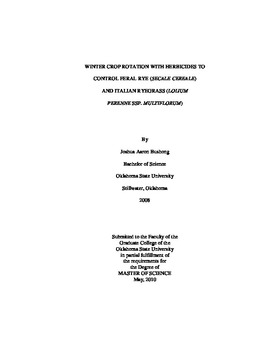| dc.contributor.advisor | Peeper, Thomas F. | |
| dc.contributor.author | Bushong, Joshua Aaron | |
| dc.date.accessioned | 2014-04-15T22:05:53Z | |
| dc.date.available | 2014-04-15T22:05:53Z | |
| dc.date.issued | 2010-05-01 | |
| dc.identifier.uri | https://hdl.handle.net/11244/9306 | |
| dc.description.abstract | Limited control options and herbicide resistance have increased feral rye and Italian ryegrass infestations in winter wheat production in Oklahoma. A rotation with winter canola would increase control options. Field experiments were established in the fall of 2007 at four sites in Oklahoma to evaluate herbicide programs for controlling these two grasses in continuous winter wheat and in a winter wheat-winter canola rotation. Factors include the herbicide treatment applied to wheat in year one (untreated, imazamox + MCPA, or pinoxaden) and the crop-herbicide combination the second year. Crop-herbicide combinations in year two included a second year of wheat with the same herbicide treatments as the first year or winter canola with eight herbicide treatments. All herbicides were applied at labelled rates with appropriate additives. Weed densities were determined prior to planting a crop the third year. Pinoxaden reduced Italian ryegrass seed in harvested wheat 88 to 100% and reduced harvested feral rye seed only 18% at two sites with no reduction at two sites the first crop year. Imazamox + MCPA reduced Italian ryegrass seed in harvested wheat 38 to 65% at three sites with no reduction at one site and reduced feral rye seed 96% at two sites and 58% at two sites the first year. Imazamox + MCPA increased wheat yields 21 to 34%. Pinoxaden increased wheat yields 14% pooled over three sites but did not affect yield at one site. Rye was sparse in all treatments the second year. Italian ryegrass control in treatments with continuous wheat was higher with any pinoxaden treatment applied one or both years than with any imazamox + MCPA treatment. Italian ryegrass control with imazamox + MCPA was inconsistent across locations. All of the herbicide treatments in winter canola except trifluralin PPI without a sequential POST treatment controlled Italian ryegrass comparable to pinoxaden applied to wheat. Italian ryegrass densities after two crops with herbicide applied were greatly reduced but the weed was not completely eliminated. | |
| dc.format | application/pdf | |
| dc.language | en_US | |
| dc.publisher | Oklahoma State University | |
| dc.rights | Copyright is held by the author who has granted the Oklahoma State University Library the non-exclusive right to share this material in its institutional repository. Contact Digital Library Services at lib-dls@okstate.edu or 405-744-9161 for the permission policy on the use, reproduction or distribution of this material. | |
| dc.title | Winter Crop Rotation with Herbicides to Control Feral Rye (Secale cereale) and Italian Ryegrass (Lolium perenne SSP. Multiflorum) | |
| dc.type | text | |
| dc.contributor.committeeMember | Murray, Don S. | |
| dc.contributor.committeeMember | Epplin, Francis M. | |
| osu.filename | Bushong_okstate_0664M_10847.pdf | |
| osu.college | Agricultural Sciences and Natural Resources | |
| osu.accesstype | Open Access | |
| dc.description.department | Department of Plant and Soil Sciences | |
| dc.type.genre | Thesis | |
| dc.subject.keywords | feral rye | |
| dc.subject.keywords | herbicides | |
| dc.subject.keywords | italian ryegrass | |
| dc.subject.keywords | winter canola | |
| dc.subject.keywords | winter crop rotation | |
| dc.subject.keywords | winter wheat | |
